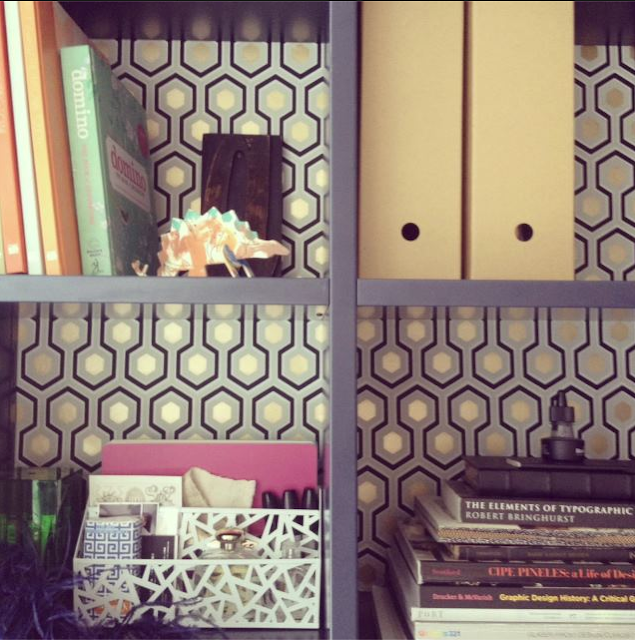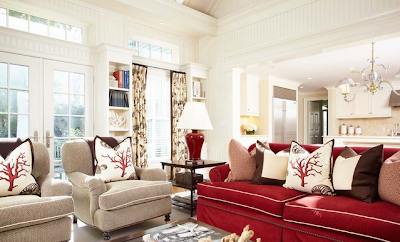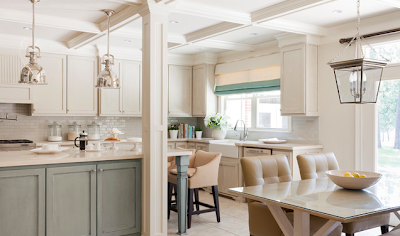Friday, August 31, 2012
Friday, August 24, 2012
How to Create a Luxurious Guest Room
Browse Furniture on Houzz- For Example:
Browse Accessories And Decor on Houzz- For Example:
Monday, August 20, 2012
Wednesday, August 15, 2012
How to Make Your Own Chalkboard Paint
Chalkboard paint is popular thanks to its blend of sentiment, whimsy
and practicality. Whether it's painted on walls, furniture or
appliances, chalkboard paint has certainly come a long way from the
basic green or slate gray boards used in schools.
I love the use of chalkboard paint in unexpected ways — like on the back of a kitchen island or in place of a headboard — but I'm also a classic girl at heart and a fan of the simple chalkboard. The recent transformation of my son's nursery to big kid room had me painting stripes, and I couldn't resist throwing a chalkboard into the mix.
I love the use of chalkboard paint in unexpected ways — like on the back of a kitchen island or in place of a headboard — but I'm also a classic girl at heart and a fan of the simple chalkboard. The recent transformation of my son's nursery to big kid room had me painting stripes, and I couldn't resist throwing a chalkboard into the mix.
Chalkboard paint is available in varying shades of color through manufacturers like Hudson Paint,
but at $25 per quart, it can get expensive. Save your pennies and have
complete control over the color by making your own in three steps.
|
Materials:
|
1. Mix the latex paint with the non-sanded grout in a cup or bucket.
A good ratio to use is 1 part grout to 8 parts paint. So, if you're
mixing a small amount, mix 1 tablespoon grout with a ½-cup paint. For a
larger amount — like I used — mix 1 cup of grout with a ½ gallon of
paint.
Ensure that all the grout is mixed in — otherwise, the granules may be visible on the chalkboard. I have found that a paint mixer drill attachment and a 5 gallon bucket is the simplest and most efficient way to blend a larger amount of paint.
Note: Grout is typically only available in large quantities — 10 pound boxes for around $12 — so plan accordingly. I knew I would be regrouting the shower and bought the Polyblend Non-Sanded grout to match. Don't have any tiling plans in your future? You may have a friend who recently tiled an entry or bathroom, so ask to use some of theirs.
To cut the sheen in the high-gloss black "oops" paint I picked up at a discount and achieve the classic charcoal color I wanted, I mixed a ½ gallon of the black paint with 2 cups of white ceiling paint, then added the grout.
Ensure that all the grout is mixed in — otherwise, the granules may be visible on the chalkboard. I have found that a paint mixer drill attachment and a 5 gallon bucket is the simplest and most efficient way to blend a larger amount of paint.
Note: Grout is typically only available in large quantities — 10 pound boxes for around $12 — so plan accordingly. I knew I would be regrouting the shower and bought the Polyblend Non-Sanded grout to match. Don't have any tiling plans in your future? You may have a friend who recently tiled an entry or bathroom, so ask to use some of theirs.
To cut the sheen in the high-gloss black "oops" paint I picked up at a discount and achieve the classic charcoal color I wanted, I mixed a ½ gallon of the black paint with 2 cups of white ceiling paint, then added the grout.
2. Paint the surface with the chalkboard paint. Prep the surface as you would for any paint job. I painted two coats for even coverage.
While I've used a classic charcoal gray, the color options are endless. Make chalkboard paint out of your leftover wall paint for a seamless and fun addition to a room or go bold with a bright, contrasting color.
While I've used a classic charcoal gray, the color options are endless. Make chalkboard paint out of your leftover wall paint for a seamless and fun addition to a room or go bold with a bright, contrasting color.
3. Condition the chalkboard. Get
your chalkboard ready for drawing by rubbing the board with chalk, then
wiping it off with a dry towel in circular strokes. With that final
step, it's ready to be put to good use.
|
In my son's room, I've gone big
by painting an entire wall with chalkboard paint and framing it to
create a place that can be used for both play and educational
activities.
More: Grown-Up Ideas For Chalkboard Paint
From Houzz.com: by Meg Padgett
|
How to Use Wallpaper in Flexible, Inexpensive, Low Commitment, and Powerful Ways- Wallpaper as an Accent
If you rent your home, have a tight budget, or simply have a hard time committing to permanent wallpaper, then try this! Create panels that slip into the back of your bookshelf. Cover them with wallpaper (using a staple gun works perfectly) and slide them in to create a high impact statement in your home that is both budget friendly and temporary.

Domino Challenge Announcement: Wallpaper Wednesday
Sunday, August 12, 2012
How to Work with and Hire an Interior Designer
When most people think about hiring an interior designer, they
zero in on aesthetics: wall colors, window treatments, pillow patterns.
But that's just scratching the surface of what a designer can add to a
home. These pros go beyond cosmetic concerns to ensure that a space
feels harmonious through and through, from its floor plan and
architectural envelope to the last nailhead, tassel and tuft. Many states have a certification process for interior designers.
Not sure what your style is? Check out these descriptions of interior design styles and how to achieve the look in your house.
 What an interior designer does: A designer envisions, plans and
outfits spaces in a way that makes them both beautiful and functional.
He or she balances aesthetic considerations with structural planning to
reflect the clients' lifestyle, set the desired mood, complement the
home's architectural features, and ensure that less glamorous details
(like electrical outlets and air vents) fit into the scheme. An interior
designer also cultivates relationships with trusted artisans, vendors
and others who execute the design.
What an interior designer does: A designer envisions, plans and
outfits spaces in a way that makes them both beautiful and functional.
He or she balances aesthetic considerations with structural planning to
reflect the clients' lifestyle, set the desired mood, complement the
home's architectural features, and ensure that less glamorous details
(like electrical outlets and air vents) fit into the scheme. An interior
designer also cultivates relationships with trusted artisans, vendors
and others who execute the design. When to hire one: You may have a clear vision for your home, but an interior designer can help you bring it to life while making sure it satisfies nitty-gritty considerations such as space planning. A trained eye and a creative mind-set allow for devising solutions that you might never have imagined, and attention to the tiniest details will transform your space into a haven that looks polished and pulled together.
 What it will cost: Interior designers have various fee
structures. They might charge an hourly rate (anywhere from $50 to
$500); a flat fee, which could be as low as several thousand dollars and
as high as five figures; or a percentage of total project costs. You
may also be asked to pay a retainer before work begins.
What it will cost: Interior designers have various fee
structures. They might charge an hourly rate (anywhere from $50 to
$500); a flat fee, which could be as low as several thousand dollars and
as high as five figures; or a percentage of total project costs. You
may also be asked to pay a retainer before work begins.Some designers take an approach known as cost-plus — they purchase materials, furnishings and more at a discount, then charge you the retail price, keeping the difference as their fee. If yours uses this method, be sure the cost discrepancies are transparent so that you'll know exactly what you're paying for services.
If you're on a tight budget, don't assume that hiring a designer is beyond reach. Many will be happy to arrange a few hours of consulting or will help you source furnishings and decorative accents.
Where to find one: The directory of interior designers
on Houzz is a good starting place, where you can find designers in your
area and beyond and view their portfolios. Your local chapter of the
American Society of Interior Designers (ASID) is also a good source.
If you spot a room you love when browsing Houzz photos and ideabooks, take note of the designer's name. (You'll see a link to professionals' profiles in the lower-right corner of their photos.) Some designers will work with clients who are based in other cities, though travel time and expenses can add up.
Friends with fabulous houses are another likely source. You can also visit show houses and home tours to see which spaces strike your fancy.
If you spot a room you love when browsing Houzz photos and ideabooks, take note of the designer's name. (You'll see a link to professionals' profiles in the lower-right corner of their photos.) Some designers will work with clients who are based in other cities, though travel time and expenses can add up.
Friends with fabulous houses are another likely source. You can also visit show houses and home tours to see which spaces strike your fancy.
Be sure the designer is a good match for your style. No two
clients are alike, and good interior designers are nimble enough to hop
from urban pied-à-terre to rustic farmhouse to beachside getaway without
missing a beat. However, almost all of them have a fundamental
aesthetic that remains consistent throughout their work. For example, if
you want pure whites and pale neutrals, don't choose a designer whose signature is bold color palettes. When interviewing designers, look for parallels between their previous work and the design you want.
Collect samples. Even if you have trouble articulating your desired look, pictures of rooms you love can instantly give the designer a sense of what you crave. He or she will ask you about specific points of the design that resonate with you and use those as guidelines. Fabric swatches, paint chips, furniture catalogs and your own Houzz ideabooks are other good sources for showing items you like. On the flip side, pull examples of colors, motifs and furniture styles that turn you off, which can be equally helpful.
Collect samples. Even if you have trouble articulating your desired look, pictures of rooms you love can instantly give the designer a sense of what you crave. He or she will ask you about specific points of the design that resonate with you and use those as guidelines. Fabric swatches, paint chips, furniture catalogs and your own Houzz ideabooks are other good sources for showing items you like. On the flip side, pull examples of colors, motifs and furniture styles that turn you off, which can be equally helpful.
Decide in advance which pieces must stay. Not willing to get rid
of your Biedermeier sideboard or your majolica collection? The process
will go more smoothly if you share that information with your designer
during the initial site visit and consultation. That way, he or she can
plan around the items that you don't want to give up.
Involve the designer as early as possible in the building process. If you're remodeling or building from scratch, include the designer in the planning stages with your architect and contractor. This way, the pros involved will all be on the same page and can iron out any potential discrepancies — particularly those that involve the bones of a home, such as doorways, ceiling beams or interior columns. It's one thing to reorient a window on paper; it's another entirely to move it after installation.
Involve the designer as early as possible in the building process. If you're remodeling or building from scratch, include the designer in the planning stages with your architect and contractor. This way, the pros involved will all be on the same page and can iron out any potential discrepancies — particularly those that involve the bones of a home, such as doorways, ceiling beams or interior columns. It's one thing to reorient a window on paper; it's another entirely to move it after installation.
Try to have all household members present at the outset. Having
everyone's input from the get-go helps to avoid potential conflicts down
the road. If a spouse or loved one objects to a certain color or
reveals that he or she just can't part with Granny's antique dining
table, it's easiest to work out those issues right away.
Ask the designer to clarify billing procedures. Find out at the beginning when you'll be charged and what for. In addition to the design itself, you may be billed for travel time, site visits, shopping, phone conversations and more. Also, ask whether you'll be getting furnishings, accents, materials or other items at a discounted rate. This way, you'll be able to anticipate fairly closely what and when to pay.
Ask the designer to clarify billing procedures. Find out at the beginning when you'll be charged and what for. In addition to the design itself, you may be billed for travel time, site visits, shopping, phone conversations and more. Also, ask whether you'll be getting furnishings, accents, materials or other items at a discounted rate. This way, you'll be able to anticipate fairly closely what and when to pay.
Keep an open mind. It's a rare client who loves 100 percent of a
designer's suggestions right off the bat. Your designer might recommend a
piece of furniture or a wallpaper pattern that you're iffy about, but
don't say no without giving the idea some time to sink in. Chances are
that when you ask your designer why he or she chose it, and when you
take a little time to live with it, you'll appreciate the reason it
works.
Look toward refreshing down the road. Even the best design doesn't stay current forever. Ask your designer if tune-up visits in the future are an option, whether they involve simply swapping out a few accessories, reupholstering furniture or choosing new paint colors.
Look toward refreshing down the road. Even the best design doesn't stay current forever. Ask your designer if tune-up visits in the future are an option, whether they involve simply swapping out a few accessories, reupholstering furniture or choosing new paint colors.
To see the original article and designer credit click on Houzz.com
Subscribe to:
Comments (Atom)






























